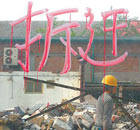Op-Ed Contributors
Balancing urban-rural progress
By Peng Zhenhuai (China Daily)
Updated: 2010-01-22 07:45
 |
Large Medium Small |
China's first central document of the year has again focused on rural problems, just as it has done for the past six years since 2004.
The themes of the previous top central documents, beginning in 2004, were respectively: Increasing the income of farmers; promoting agricultural production capacity; advancing the construction of the "new countryside"; developing modern agriculture; strengthening agricultural infrastructure construction; and promoting the stable development of agriculture and increasing the income of farmers in 2009.
In contrast, the top central document this year focuses on coordinating urban-rural development, which indicates that solutions for issues concerning agriculture, the countryside and farmers will not be sought independently.
The top central document this year focuses on balancing urban-rural development as a fundamental requirement. This balance will help build a moderately prosperous society in all respects and promote urbanization as a prime factor in maintaining a steady, fast economic growth. Urbanization is the Chinese government's hope for a new growth engine.
But I believe current urbanization, highlighted by the document, should home in on the development of small towns rather than large, medium and small cities.
There have been persistent controversies over whether China needs to develop small towns and how it should develop them. In 1953, there was general consensus that large cities are not conducive to development and small towns are preferable; the policy in 1980 was to control the size of large cities, develop medium-sized cities and proactively develop small cities. The tone in 1990 was to strictly control the scale of large cities and develop medium- and small-sized cities to an appropriate extent; since 2002 it was adjusted to coordinate development between cities of any scale in size as well as small towns.
The ever-changing priority leads to suspicion on the effect, status and function of developing small towns that has led to dispersion of policy and fund resources. China's one-sided view on the concept of "urbanization" has exacerbated the contradiction between urban expansion and resources, environmental and ecological bearing capacity.
Differences over people's understanding of urbanization might appear in three aspects. First, does urbanization mainly entail developing large, medium and small cities? Second, should it be mainly referring to small towns? Third, if it refers to small towns, should it include established townships or market towns without grassroots institution?
In terms of scale, the scope of influence and development level, there are essential differences between townships and cities as well as market towns. From the policy level of balancing urban-rural development, townships should not include all types of cities and market towns.
Compared with rural areas, a township is a community composed mainly of a nonagricultural population and nonagricultural industries in a state of rural-urban transition. Compared with cities, a township is inextricably tied up with rural areas in terms of geography, population, economy, culture and environment, playing a role in organization and leadership on rural affairs. So if we take the development of townships as a priority in coordinating urban-rural development, we could net twice the result with half the effort.
China's national conditions have shown that for a long time, the majority of the population could only be engaged in a traditional agricultural lifestyle, and staying in rural areas. The major issue that impacts China's development presently and in the future is employment. The most crucial aspect of employment is the transfer of rural labor into the urban sector. So the transfer of rural workers to townships in the hunt for jobs is conducive not only to township development but also to rural poverty alleviation and new countryside construction.
A township - which connects urban and rural areas, agriculture and industry - is a base supplying public goods and services for the rural community. At present, the proportion of agricultural added value in China's gross domestic product has been reduced to 15 percent from 30 percent and is declining. Increasing the income of farmers cannot be resolved by developing traditional agriculture.
A more feasible approach is to start from townships and build a new socialist countryside with modern means for agricultural production and rural life.
The development path that a country chooses is determined by its own specific historical, political, economic and cultural conditions. Developing the countryside is the hardest part in China's drive to become modernized, but it is also where the hope remains. As the connecting part of cities and rural areas, townships could play a role as the carrier of agricultural industrialization, the base of production and life for farmers, and the foundation for advancing the construction of the new countryside.
The author is the director of Local Government Research Institute under Peking University.
(China Daily 01/22/2010 page8)













